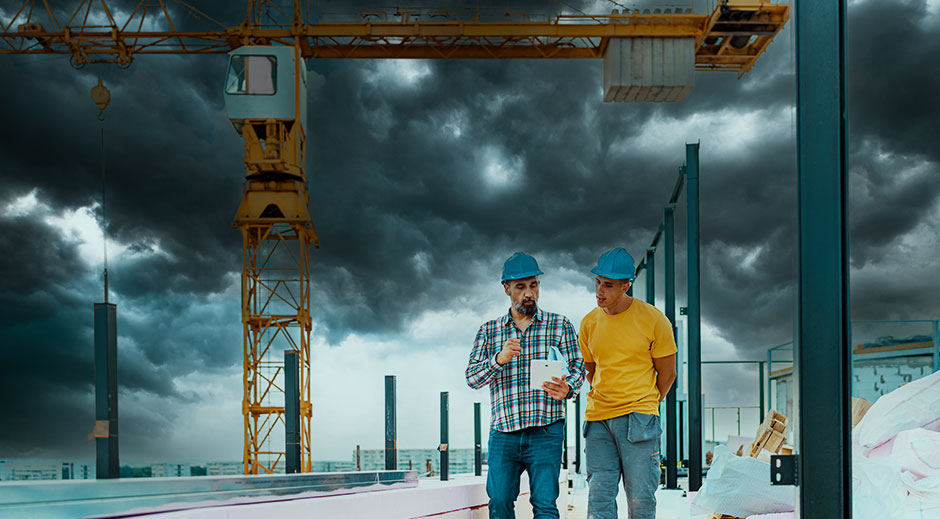
Efficiency and safety are everything in the world of construction, and weather can be the enemy of both. As weather events like major storms and heatwaves seem to grow in severity and frequency each year, navigating the challenge of weather volatility is more important to the bottom line than ever before.
Moving forward, we’ll explore…
- What weather challenges “look like” at ground level for construction and engineering firms
- The kinds of approaches and tools necessary to tackle growing weather challenges
- How construction firms can build weather safety into contracts to protect margins and workers alike
Weather challenges affecting the construction industry
In the construction industry, weather plays a pivotal role that extends beyond simply dictating whether work can proceed on a given day. There are four main weather challenges that construction companies must grapple with: worker safety, site and equipment protection, daily assignments and routing, and deadline management.
Worker safety
Worker safety stands as a paramount concern at construction sites. Extreme weather conditions, such as intense heat, cold, or wind, can pose significant health risks to construction workers, including heatstroke, hypothermia, or accidents caused by strong gusts.
According to the Occupational Safety and Health Administration (OSHA), the weather can be a factor in any of the “Focus Four” hazard groups for construction: falls, electrocution, being struck by objects, or becoming caught in or between objects. This underscores the importance of implementing effective safety measures to protect workers against the threat of weather.
Site and equipment protection
Secondly, adverse weather conditions can wreak havoc on construction sites and equipment. Heavy rainfall, for instance, can cause flooding and soil erosion, compromising the integrity of the structures being built and leading to costly damages. Similarly, equipment exposed to harsh elements may suffer from wear and tear more rapidly, necessitating expensive repairs or replacements.
Daily assignments and routing
The third challenge revolves around daily assignments and routing. For instance, a sudden storm might halt crane operations, while foggy conditions could disrupt the transport of materials, both scenarios resulting in lost time and productivity.
Weather conditions can disrupt the planned flow of activities, forcing project managers to constantly adjust schedules and reroute workers and materials so meaningful progress can be made wherever the weather allows.
Deadline management
The cumulative effect of these weather-related disruptions is often delays in meeting project deadlines. The construction industry operates on tight schedules where time equates to money. Delays due to weather not only lead to financial losses but also damage a company's reputation, particularly if it consistently fails to deliver projects on time.
These challenges matter greatly as they can directly impact the bottom line for construction companies. They affect the well-being of workers, lead to costly damages and repairs, hinder productivity and efficiency, and result in financial losses due to missed deadlines. By understanding and preparing for these challenges, construction companies can mitigate their effects and ensure smoother project execution, even in the face of unpredictable weather.
Regulatory compliance
EPA guidance stresses that stormwater can carry pollutants from construction sites into local waterways. For any sites larger than one acre, a Clean Water Act permit is required to discharge stormwater from a worksite.
Getting that permit requires both effective pollution and erosion control measures in place. Weather and stormwater flow monitoring solutions are therefore key for construction and engineering firms looking to illustrate that they're prepared to protect the local community and water resources in order to earn their Clean Water Act permit.
How can construction firms fight back against weather challenges?
Better forecasting
Hyperlocal forecasts can provide advanced warning about potential adverse weather conditions, allowing construction companies to take proactive measures.
For instance, knowledge of an impending heatwave could prompt site managers to schedule breaks, provide additional shade, or even reschedule work to cooler parts of the day to prevent heatstroke. Similarly, foreknowledge of a pending storm or intense winds can lead to the suspension of high-risk activities, such as crane operations, to prevent accidents.
This level of detailed, location-specific information helps create safer work environments and protect workers from weather-related hazards.
On-site monitoring
On-site weather monitoring at construction sites is not just helpful, but essential for several reasons. It contributes to enhanced safety, improved project planning, automated compliance documentation, and the protection of expensive equipment. Monitoring with weather stations and sensors provides real-time data, enabling construction companies to make informed decisions and proactive measures.
Weather, unpredictable as it is, can throw a wrench in the most meticulously planned schedule. However, with on-site weather monitoring, project managers can increase the accuracy of their forecasts, allowing them to adjust work schedules and resource allocation proactively and with confidence. This level of planning can save valuable time and money by reducing weather-related downtime.
Automated weather alerts
Receiving automated alerts and notifications about current and developing weather conditions can be an invaluable resource for construction companies. This real-time, predictive information can significantly enhance safety measures, increase operational efficiency, protect valuable assets, and help in effective project management.
Construction projects represent a substantial investment, and exposure to harsh weather conditions can lead to costly damage and setbacks. Automated alerts on upcoming severe weather allow companies to move equipment, secure the site, and relocate workers, preventing potential damage and the associated repair or replacement costs.
Automated alerts and notifications about current and developing weather conditions provide construction companies with a powerful tool for proactive management. They facilitate a safer working environment, promote operational efficiency, safeguard valuable assets, and contribute to successful project completion - all crucial components in the competitive and challenging world of construction.
How to leverage best-in-class weather solutions without sacrificing profits
Construction companies often mistakenly assume that leading weather safety tools and solutions are prohibitively expensive. In fact, they have the ability to make these crucial tools affordable by incorporating them into contracts and passing the associated costs along to the customer. This approach not only allows construction companies to deliver projects effectively and efficiently but also provides better accountability to deadlines and creates a safer overall work environment.
Writing weather safety into your proposal or RFP response
By including weather safety provisions in contracts, construction companies can ensure that the necessary tools and solutions are readily available on-site. This may include automated weather monitoring systems, protective gear, or contingency plans to mitigate potential weather-related disruptions. While there may be initial costs involved in implementing these measures, they can be included as part of the overall project budget and shared with the customer.
In return for the investment in weather safety, construction companies can provide enhanced accountability to deadlines. By proactively addressing weather challenges, they can minimize delays caused by adverse conditions. This not only benefits the construction company but also the customer, who can have confidence in the project's progress and timely completion.
Furthermore, prioritizing weather safety measures creates a safer overall environment for workers and stakeholders. Accurate weather monitoring and appropriate safety protocols help prevent accidents and ensure the well-being of everyone involved. By making weather safety a priority, construction companies demonstrate their commitment to the health and safety of their workforce, fostering a positive work culture and reputation.
Construction companies should recognize that the perception of weather safety tools and solutions as prohibitively expensive is misguided. By incorporating these measures into contracts and passing the costs along to customers, construction companies can ensure affordability while delivering projects effectively and quickly. This approach not only offers better accountability to deadlines but also creates a safer overall work environment. It is a win-win situation that benefits both construction companies and their valued customers.
Work with a weather services specialist who knows construction
AEM's expertise in weather monitoring and alerting can provide invaluable assistance to construction companies, helping them navigate the challenges posed by unpredictable weather conditions. By leveraging AEM's services, construction companies can optimize their daily activities based on accurate forecasting intel, keep workers informed and safe, and improve project management efficiency.
If that sounds like something you're interested in, let's talk!
Our weather monitoring and alerting services enable construction companies to align their work with current and incoming weather conditions. By receiving real-time updates and high-accuracy forecasts, companies can plan their operations accordingly, optimizing resource allocation and scheduling.
This proactive approach allows for better decision-making, avoiding potential disruptions caused by adverse weather. Whether it's rescheduling outdoor tasks to avoid heavy rain or adjusting work hours to mitigate extreme heat, AEM's expertise empowers construction companies to make informed choices that maximize productivity and worker safety.
We also provide clear and timely alerts to construction workers at potentially affected sites. These alerts inform workers when to expect weather-related disruptions, when to seek shelter, and when it's safe to resume work. By keeping workers informed and prepared, AEM helps minimize risks and ensures the well-being of personnel on-site. Construction companies can rely on AEM's accurate information to enhance their safety protocols and maintain a responsible work environment.
.png?width=760&height=424&name=MicrosoftTeams-image%20(20).png)




